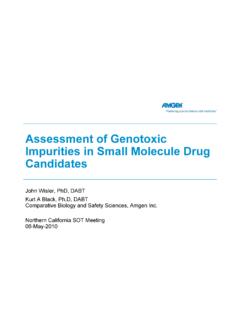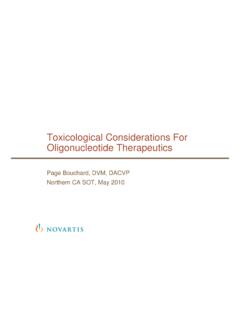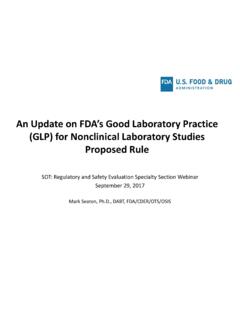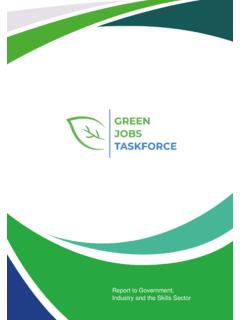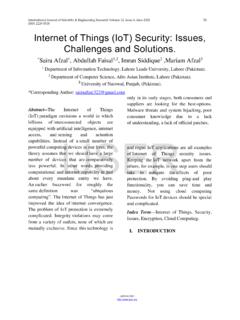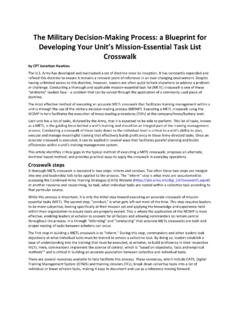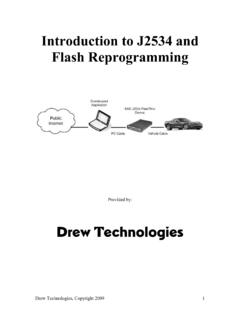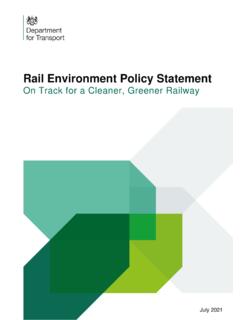Transcription of Regulatory Toxicology
1 Regulatory Toxicology Regulatory (Pharmaceutical) Toxicology Ruth Roberts Director, ApconiX Ltd Chair of Drug Discovery, University of Birmingham, UK Conflict of Interest Declaration Ruth Roberts is co-founder and co-director of Apconix, an integrated Toxicology and ion channel research company that provides expert advice on nonclinical aspects of drug discovery and drug development to academia, industry, government and not-for-profit organisations. Overview/Objectives Outline and purpose of Regulatory Toxicology testing for pharmaceuticals Overall design of the package from first time in humans (FTIH) through to marketing authorisation Purpose: ensuring volunteer and patient safety in clinical trials Decision making General Toxicology Maximum tolerated dose (MTD)/Dose Range Finding (DRFs), pivotal and chronic Toxicology studies Design (doses, species, duration) and outcome Regulatory documentation Outline of general Toxicology testing for agrochemicals and general chemicals challenges and opportunities Translation Attrition Assumptions to challenge In vitro replacements Future Perspectives Understand the purpose of pharmaceutical Toxicology Understand the pivotal role played by general Toxicology studies in protecting volunteer and patient safety Understand common principles with other sectors (agrochemicals, general chemicals) Understand outcome of general Toxicology studies and the principles and caveats of their designs Understand the global framework provided by the International Council for Harmonisation of Technical Requirements for Pharmaceuticals for Human Use (ICH)
2 Understand the scope for scientific interpretation (guideline versus rules ) Have a perspective on challenges to the current paradigm of Toxicology testing in support of Regulatory submissions Regulatory Toxicology : Learning Objectives Discovery Development Orientation: Clinical Development of a New Drug Target selection (TS) Lead generation (LG) and optimisation (LO) Candidate drug (CD) prenomination Good Laboratory Practice (GLP) Toxicology Phase Phase II: Early patient studies, tolerance, kinetics, pharmacology, efficacy (proof of concept), dose range, drug interactions, special patient populations Phase III: data for registration via double-blind trials against competitors on efficacy and safety Phase IV: Post marketing surveillance and market positioning Phase IV 10s 100s 1000s 10000+++ Phase I Phase II Phase III Phase I: Healthy volunteers usually male, tolerance, kinetics, pharmacology (proof of mechanism) Phase I: Late stage cancer patients, tolerance, kinetics, scheduling, pharmacology (proof of mechanism) Exposure Effect Efficacy Toxicity Desired Efficacy (eg ED90) Acceptable Toxicity (Normally the No observed adverse effect level or NOAEL) Safety Margin Aim of Preclinical Testing is to Determine Safety Margins Safety margin (SM) calculation: Exposure at the NOAEL = SM Predicted exposure required for clinical efficacy For benign indications, 100-fold margin may be appropriate For terminal conditions, much lower margin may be acceptable Discovery Development Phase I Phase II Phase III 106 104 10 1-2 1 A Progression from Nonclinical to Clinical Weight of Evidence Clinical data Pre-clinical data Preclinical data are critical for the FTIH decision Clinical safety data become increasingly important as clinical trials progress Human data outrank nonhuman data in assessing human safety!
3 Target selection (TS) Lead generation (LG) and optimisation (LO) Candidate drug (CD) prenomination Good Laboratory Practice (GLP) Toxicology Phase Discovery Development TS LG & LO CD GLP Toxicology Phase Phase I Phase II Phase III Project-specific requirements Provide safety information on one compound to allow entry into clinical trials and it s registration and prescription Establish whether inherent toxicity is acceptable for the patient population Design unique experimental plan to assess and mitigate target or chemistry risks Traditionally the home of pharmaceutical Toxicology Regulatory requirement Identify early the safety risks associated with target and chemistry in patient setting Problem solve any findings: MOA and relevance to humans? May have multiple lead series and test molecules for each Influence chemical design and selection to avoid issues where possible 106 104 10 1-2 1 Discovery and Development Toxicology Regulatory Toxicology : What Is It and What s It For?
4 ICH: International Council for Harmonisation ..Interpretation and application of technical guidelines for drug A unique undertaking that brings together the drug Regulatory authorities and pharmaceutical industry of Europe, Japan and the US . Discovery Development CD Nomination FTIH TS LG/LO CD prenomination GLP Toxicology Phase Phase I Phase II Phase III General Toxicology ICH M3 (R2), S9, S4 One month + recovery. MTD/DRF Target/chemistry issues - bespoke approaches Chronic Toxicology Safety Pharmacology (ICH S7) Core battery: Cardiovascular, CNS, Respiratory + follow up/ supplemental studies as needed Genetic Toxicology and Carcinogenicity (ICH S2 (R2) & S1) Reproductive Toxicology (ICH S5 (R2)) Fertility EFD P&P SAR, Ames, MOLY, Micronucleus Carcinogenicity One month + recovery. MTD/DRF Chronic Toxicology Rodent Non Rodent Regulatory Toxicology Testing of a Small Molecule Drug Abbs: CD: candidate drug; CNS: Central Nervous System; DRF: dose range finding; EFD: Embryo Fetal Development; FTIH: first time in human; GLP: good laboratory practice; LG/LO: lead generation/lead optimisation; ICH: International Council for Harmonisation; MOLY: Mouse Lymphoma; MTD: maximum tolerated dose; P&P: peri and post natal; SAR: Structure Activity Relationship; TS: target selection Disease specific considerations: life threatening?
5 Duration of clinical use: daily versus single dosing Target populations: post-menopausal, children, males/females? Specific studies triggered by special uses: antigenicity, local tolerance, dependency? Support of Clinical Trials: Regulatory and Scientific Considerations Translating Regulatory Guidance into Preclinical Studies: Safety Evaluation of a New Small Molecule Formulation stability/homogeneity, etc. General Toxicology Acute studies (some countries) Dose Range Finding (DRF) studies in rats &dogs 1-month studies in rats &dogs 6-month studies in rats and dogs 9-month/1-year study in dogs Oncogenicity sighting study and transgenic study in the mouse 2-year studies in the rat Genetic Toxicology Ames test Micronucleus test mouse lymphoma assay Reproductive Toxicology Preliminary teratology studies in rabbits Teratology studies in rats and rabbits Fertility study in the rat Peri- and postnatal study in the rat Safety/General Pharmacology General Toxicology As specified in ICH M3 (R2), S9, S4 One month + recovery.
6 MTD/DRF Discovery Target/chemistry issues - bespoke approaches Chronic Toxicology Development CD Nomination FTIH One month + recovery. MTD/DRF Chronic Toxicology Rodent Non Rodent Registration Focus on the General Toxicology MTD/DRF: Maximum tolerated dose/dose range finding TS LG/LO CD prenomination GLP Toxicology Phase Phase I Phase II Phase III High dose (MTD from MTD/DRF) Low dose (No effect level or multiple of therapeutic dose) Mid-dose: to give a dose-response, normally the geometric mean (2, 6, 18) (2root of 2*18) High dose (MTD from one month) Low dose (No effect level or multiple of intended therapeutic dose) Mid-dose: to give a dose-response, normally the geometric mean (1, 3, 6) General Toxicology ICH M3 (R2), S9, S4 One month + recovery. MTD/DRF Target/chemistry issues - bespoke approaches Chronic Toxicology One month + recovery. MTD/DRF Chronic Toxicology Rodent Non Rodent Dose Selection and Progression Establishment of maximum tolerated dose (MTD) Followed by a repeat dose phase of 3, 7, 10 or 14 days Considerations: 1.
7 There could be limited amount of compound 2. It s usually key to demonstrate MTD for the Regulatory package 3. Skilled observation of early days of a study are crucial 4. Generally start rodent before nonrodent in case of unexpected issues 5. An intended therapeutic dose is likely to evolve with clinical experience 6. A well-designed nonclinical package informs and gives maximum flexibility to an evolving clinical plan Discovery Development TS LG/LO CD prenomination GLP Toxicology Phase Phase I: patients, scheduling with current Standard of Care 20+ cohorts Clinical Development of a New Oncology Drug: Options C 106 104 10 1-2 1 C C C C C C C Each cohort is on average 3 patients; $80 000/patient Obligation to gain maximum knowledge from each patient C C C Bespoke nonclinical studies on combinations, schedules, intervals Species Selection Two species= Regulatory requirement (historically, mainly rat and dog) Other species may be used if data suggest they are more appropriate Biological relevance Bioavailability Non-human primates or minipigs recognised alternative non-rodent species Increasing use of minipigs over dog Biotechnology compounds tend to use primates Use young, healthy animals Rodent (n supports statistics) Non-rodent (no stats) Control 10 Males + 10 Females Low dose 10M + 10F Medium dose 10M + 10F High dose 10M + 10F 28 days In-life observations Macroscopic observations Pathology Clinical chemistry Control 3 Males + 3 Females Low dose 3M + 3F Medium dose 3M + 3F High dose 3M + 3F 28 days Typical First Time in Humans (FTIH)
8 Study Design Control 10M + 10F 10M + 10F Low dose 10M + 10F Medium dose 10M + 10F High dose 10M + 10F 10M + 10F In-life observations Macroscopic observations Pathology Clinical chemistry Control 3M + 3F 3M + 3F Low dose 3M + 3F Medium dose 3M + 3F High dose 3M + 3F 3M + 3F 28 days 28 days . 28 days . Non rodent Rodent A Typical FTIH Package also Includes Recovery Outcome: target organ toxicities in first time in man (FTIM) studies and chronic studies What are the most common target organs in FTIM general Toxicology studies? Does this differ by species? An analysis of 77 AstraZeneca drugs General Toxicology under ICH M3/ICH S9 FTIM Target Organ Profiles Rodent (78 studies) Liver Adrenal glands, bone marrow, kidney, spleen and thymus Horner et al (2013) Regulatory Toxicology and Pharmacology, 65, 334-343. 0 5 10 15 20 25 30 35 Adrenal .. Femoral .. Heart Intestinal tract Lungs Oesophagus Sciatic nerves Skin Spleen Stomach Urinary.
9 Eyes Optic nerves Mouth/Oral .. Tongue Pituitary gland Thyroids & .. Epididymides Seminal .. Testes Mammary .. Uterus Number of CDs Liver, GI tract, thymus, testes FTIM Target Organ Profiles Non-Rodent (77 studies) Horner et al (2013) Regulatory Toxicology and Pharmacology, 65, 334-343. Liver Is the Most Frequent Target Organ in Rodent and Non-Rodent FTIH Studies Target Organ Non-rodent Rodent 1 Liver Liver 2 Thymus Adrenal 3 GI Spleen Kidneys Bone Marrow 4 Testes 5 Lymph nodes In-life observations Macroscopic observations Pathology Clinical chemistry Which findings are adverse? Which are relevant for humans? What are the consequences for the risk-benefit analysis? Do we progress into humans? And at what dose? What do we monitor? Application of Regulatory Toxicology to Risk Assessment Discovery Development Target selection Lead generation & optimisation Candidate drug (CD) prenomination GLP Toxicology Phase Phase I Phase II Phase III 106 104 10 1-2 1 A reminder!
10 Pivotal GLP studies are vital in the FTIH decision Clinical data Pre-clinical data Preclinical data : critical for the FTIH decision Clinical safety data become increasingly important as clinical trials progress Human data outrank nonhuman data in assessing human safety! The Regulatory submission evolves to an integrated package of non-clinical and clinical data that assesses risk-benefit in the patient context Phase I, II and III trials plus marketing authorisation progress based on submission of appropriate Regulatory documentation data from general Toxicology and other studies form these submissions Well designed, conducted and reported studies => high-quality study summaries, the building blocks of quality submissions These are assembled into a series of submissions with an executive summary that highlights key toxicological issues These issues form the basis of the sponsors risk-benefit analysis including proposed starting doses, exposure limits, patient exclusions and clinical monitoring A Word on Regulatory Submissions.



